Abstract
Our desire to understand the potential adverse human health effects of environmental chemical exposure has coincided with an increased understanding of the immune system and an appreciation of its complex regulatory network. This has spawned a broad interest in the area of immunotoxicology within the scientific community as well as certain concerns in the public sector regarding chemical-induced hypersensitivity and immunosuppression. The incidence of alleged human sensitization to chemicals has increased, in part, due to the fact that chemical companies are moving to larger and/or different markets. It has been estimated that 35 million Americans suffer from allergic disease, of which 2-5% are from occupational exposure. Although there is not yet a clear understanding of dose-response relationships or disease predisposition, there are many well-defined examples (isocyanates, anhydrides) of chemical sensitizers in humans and experimental animals. Evidence that chemicals suppress immune responses in humans is considerably less well established, although there is a public perception that chemicals generally cause immunosuppression. This perception has been fueled by highly publicized legal cases and scientific controversies within the academic and industrial communities. As a consequence of these public and scientific concerns, many of the regulatory agencies are developing immunotoxicity testing guidelines. At the present, however, there are limitations on adequate human methodology and data that allow the extrapolation of animal data to assess human risk. The potential for human immunosuppression remains of concern, however, because of a large database generated from animal studies that demonstrates immunosuppression as well as reports of immunosuppression in humans inadvertently (e.g., halogenated aromatic hydrocarbons) or occupationally (asbestos, benzene) exposed to xenobiotics.(ABSTRACT TRUNCATED AT 250 WORDS)
Full text
PDF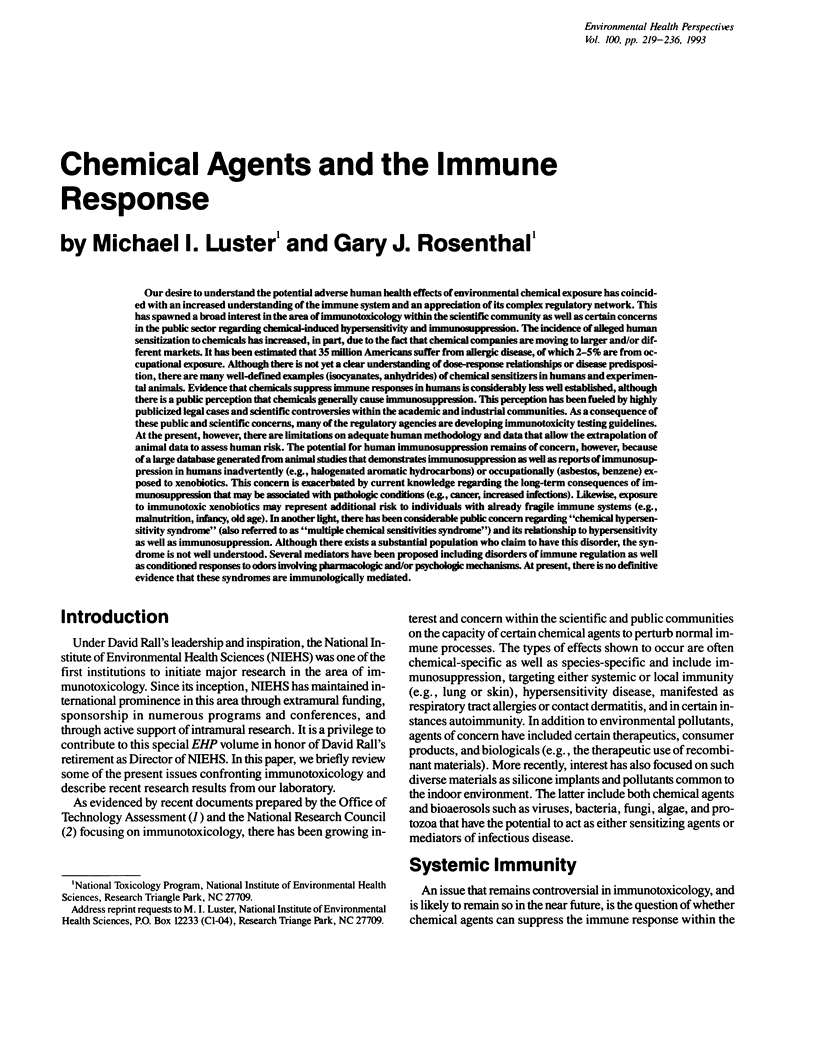
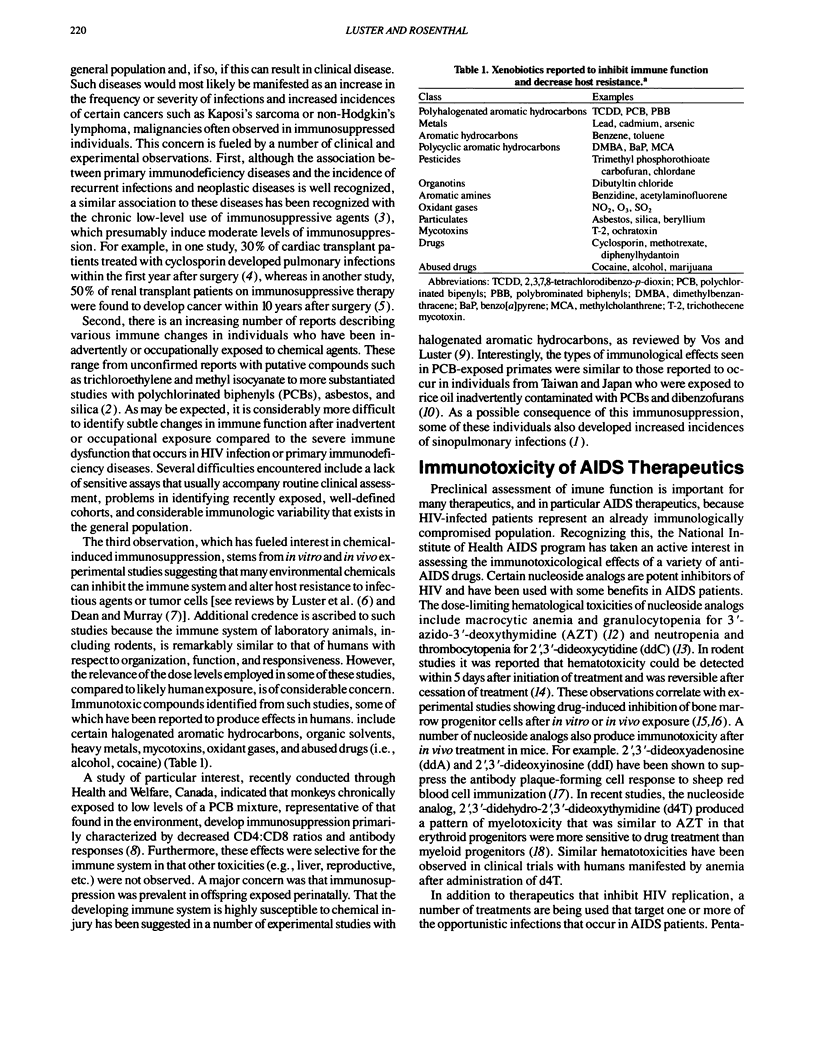
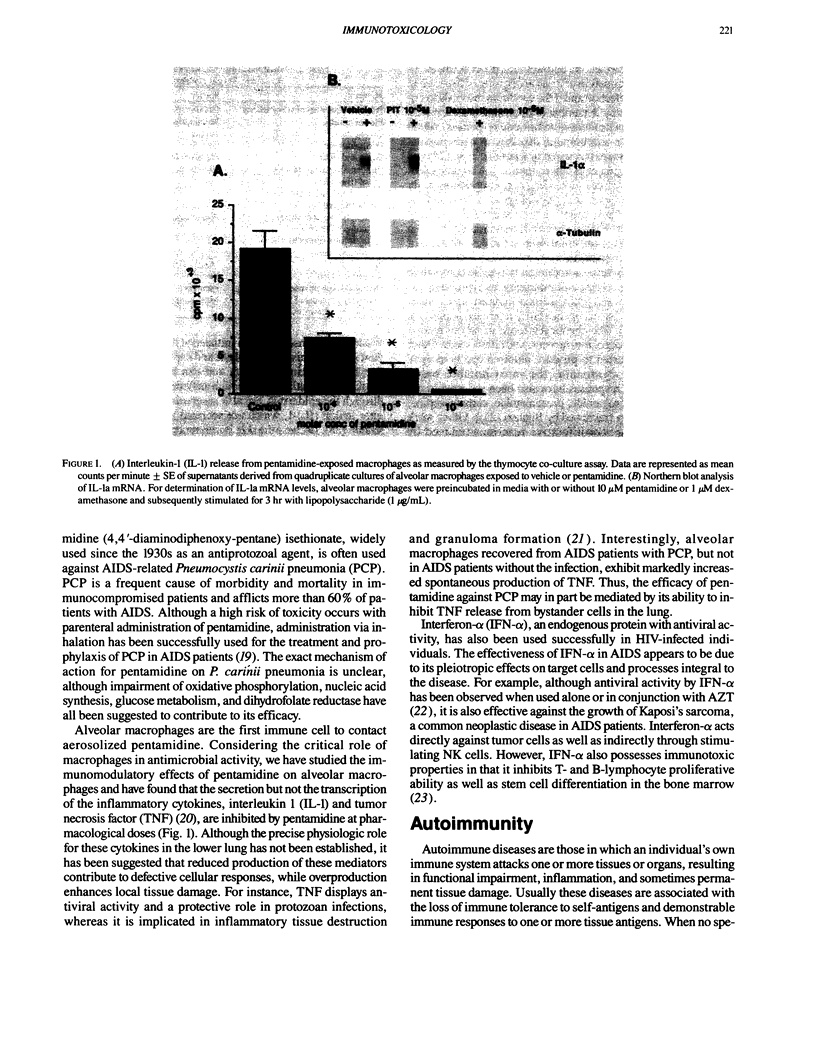
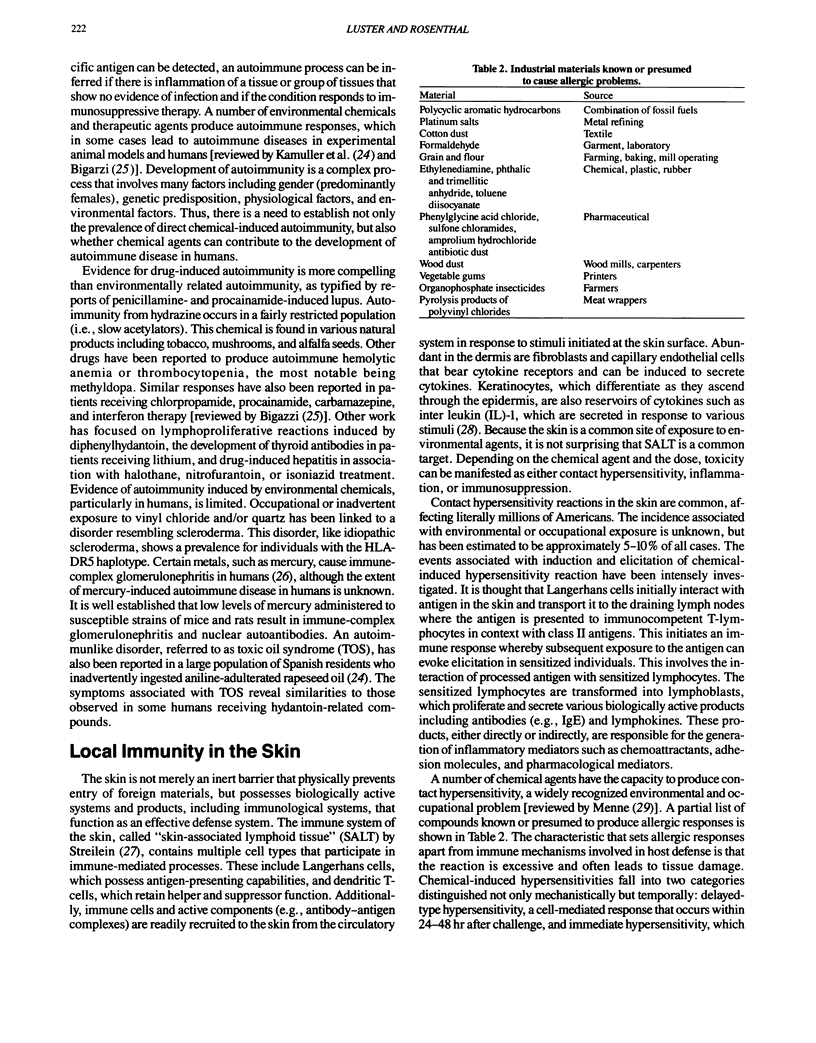
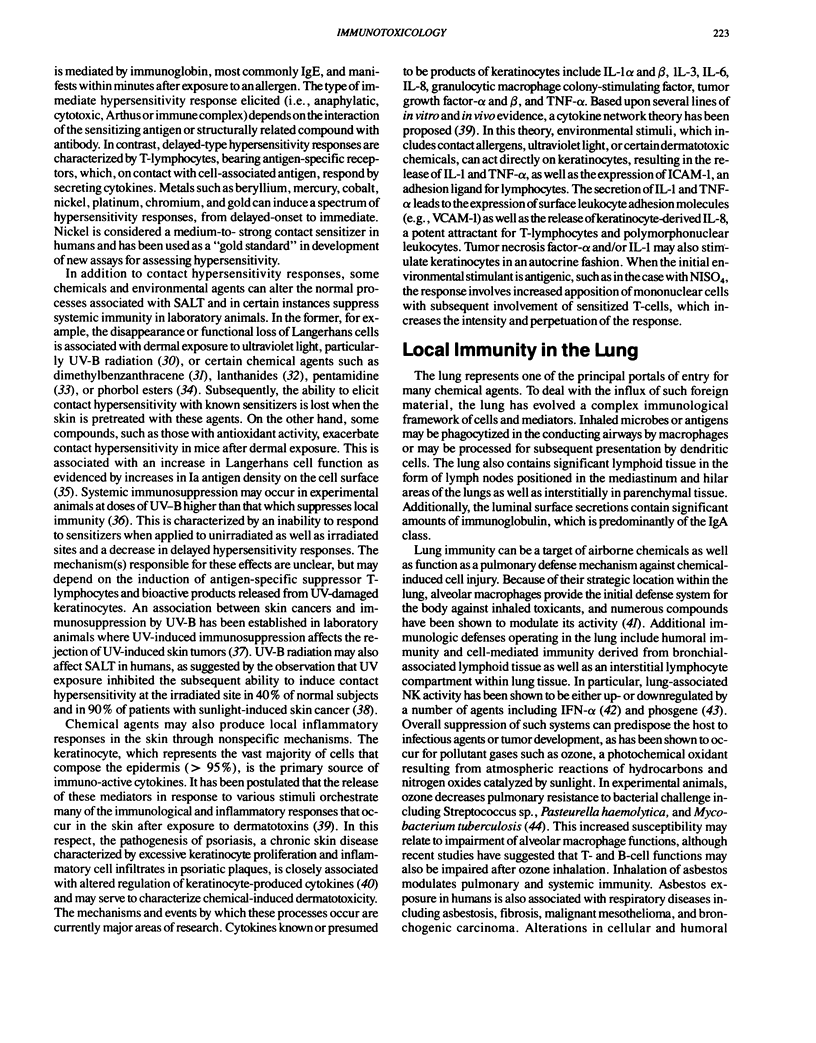
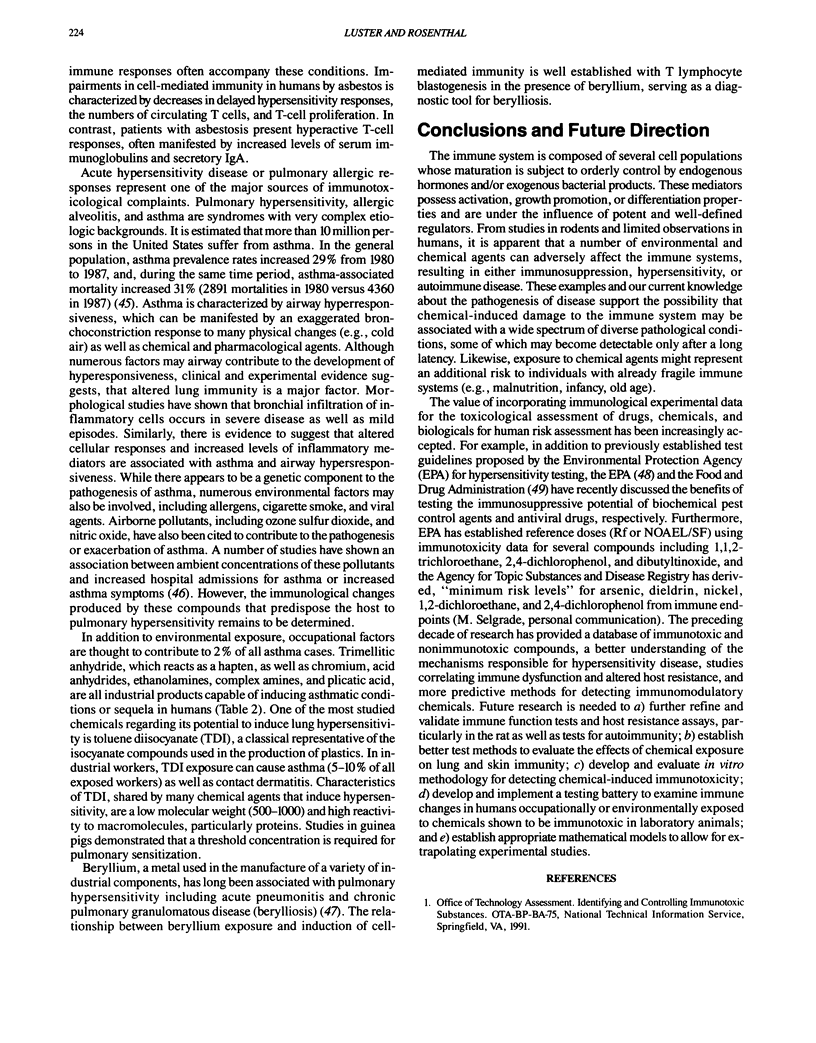
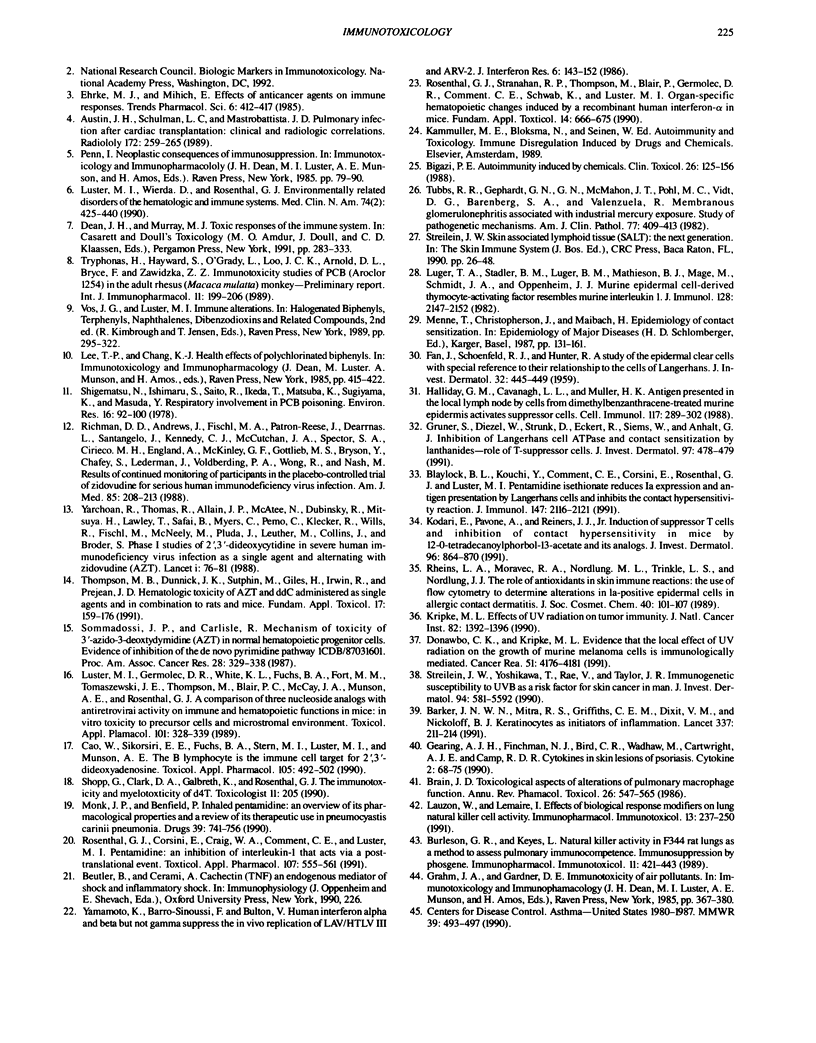
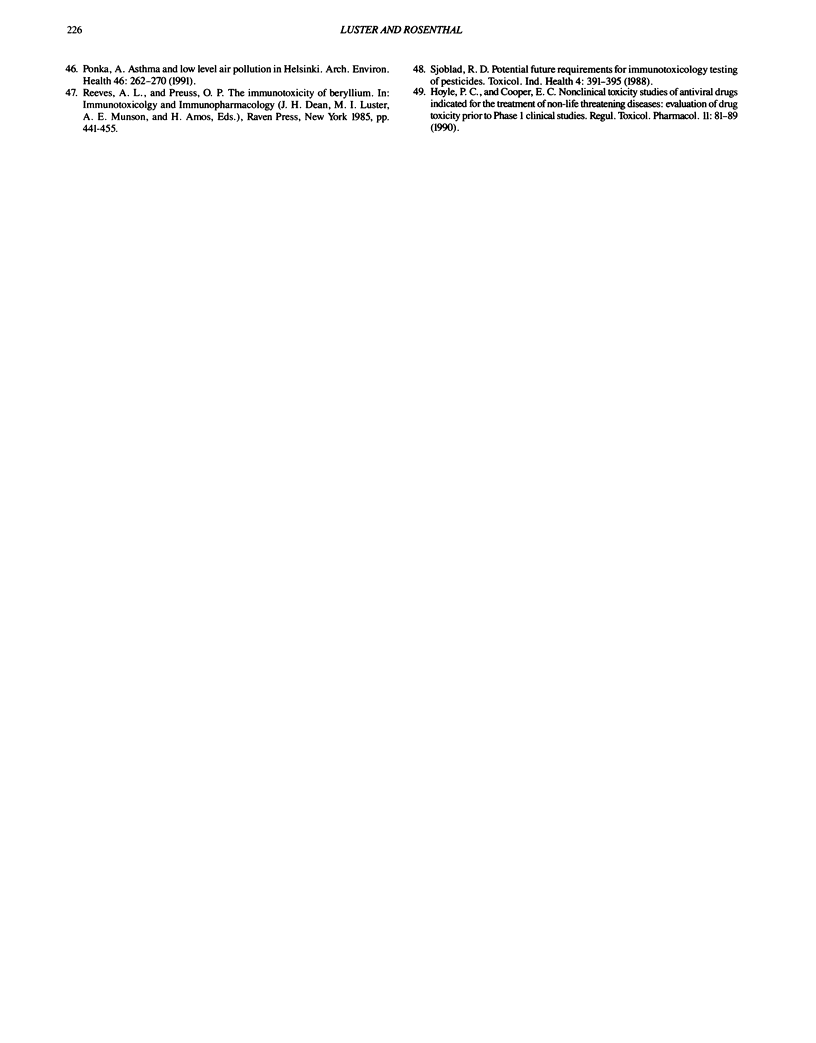
Images in this article
Selected References
These references are in PubMed. This may not be the complete list of references from this article.
- Austin J. H., Schulman L. L., Mastrobattista J. D. Pulmonary infection after cardiac transplantation: clinical and radiologic correlations. Radiology. 1989 Jul;172(1):259–265. doi: 10.1148/radiology.172.1.2544923. [DOI] [PubMed] [Google Scholar]
- Barker J. N., Mitra R. S., Griffiths C. E., Dixit V. M., Nickoloff B. J. Keratinocytes as initiators of inflammation. Lancet. 1991 Jan 26;337(8735):211–214. doi: 10.1016/0140-6736(91)92168-2. [DOI] [PubMed] [Google Scholar]
- Blaylock B. L., Kouchi Y., Comment C. E., Corsini E., Rosenthal G. J., Luster M. I. Pentamidine isethionate reduces Ia expression and antigen presentation by Langerhans cells and inhibits the contact hypersensitivity reaction. J Immunol. 1991 Oct 1;147(7):2116–2121. [PubMed] [Google Scholar]
- Brain J. D. Toxicological aspects of alterations of pulmonary macrophage function. Annu Rev Pharmacol Toxicol. 1986;26:547–565. doi: 10.1146/annurev.pa.26.040186.002555. [DOI] [PubMed] [Google Scholar]
- Burleson G. R., Keyes L. L. Natural killer activity in Fischer-344 rat lungs as a method to assess pulmonary immunocompetence: immunosuppression by phosgene inhalation. Immunopharmacol Immunotoxicol. 1989;11(2-3):421–443. doi: 10.3109/08923978909005378. [DOI] [PubMed] [Google Scholar]
- Cao W., Sikorski E. E., Fuchs B. A., Stern M. L., Luster M. I., Munson A. E. The B lymphocyte is the immune cell target for 2',3'-dideoxyadenosine. Toxicol Appl Pharmacol. 1990 Sep 15;105(3):492–502. doi: 10.1016/0041-008x(90)90152-k. [DOI] [PubMed] [Google Scholar]
- FAN J., SCHOENFELD R. J., HUNTER R. A study of the epidermal clear cells with special reference to their relationship to the cells of Langerhans. J Invest Dermatol. 1959 Mar;32(3):445–450. doi: 10.1038/jid.1959.74. [DOI] [PubMed] [Google Scholar]
- Gearing A. J., Fincham N. J., Bird C. R., Wadhwa M., Meager A., Cartwright J. E., Camp R. D. Cytokines in skin lesions of psoriasis. Cytokine. 1990 Jan;2(1):68–75. doi: 10.1016/1043-4666(90)90045-u. [DOI] [PubMed] [Google Scholar]
- Gruner S., Diezel W., Strunk D., Eckert R., Siems W., Anhalt G. J. Inhibition of Langerhans cell ATPase and contact sensitization by lanthanides--role of T-suppressor cells. J Invest Dermatol. 1991 Sep;97(3):478–482. doi: 10.1111/1523-1747.ep12481515. [DOI] [PubMed] [Google Scholar]
- Halliday G. M., Cavanagh L. L., Muller H. K. Antigen presented in the local lymph node by cells from dimethylbenzanthracene-treated murine epidermis activates suppressor cells. Cell Immunol. 1988 Dec;117(2):289–302. doi: 10.1016/0008-8749(88)90119-0. [DOI] [PubMed] [Google Scholar]
- Hoyle P. C., Cooper E. C. Nonclinical toxicity studies of antiviral drugs indicated for the treatment of non-life-threatening diseases: evaluation of drug toxicity prior to phase 1 clinical studies. Regul Toxicol Pharmacol. 1990 Feb;11(1):81–89. doi: 10.1016/0273-2300(90)90009-z. [DOI] [PubMed] [Google Scholar]
- Killer H. E., Hess K. Natural history of radiation-induced brachial plexopathy compared with surgically treated patients. J Neurol. 1990 Jul;237(4):247–250. doi: 10.1007/BF00314628. [DOI] [PubMed] [Google Scholar]
- Kodari E., Pavone A., Reiners J. J., Jr Induction of suppressor T cells and inhibition of contact hypersensitivity in mice by 12-O-tetradecanoylphorbol-13-acetate and its analogs. J Invest Dermatol. 1991 Jun;96(6):864–870. doi: 10.1111/1523-1747.ep12475179. [DOI] [PubMed] [Google Scholar]
- Kripke M. L. Effects of UV radiation on tumor immunity. J Natl Cancer Inst. 1990 Sep 5;82(17):1392–1396. doi: 10.1093/jnci/82.17.1392. [DOI] [PubMed] [Google Scholar]
- Lauzon W., Lemaire I. Effects of biological response modifiers on lung natural killer activity. Immunopharmacol Immunotoxicol. 1991;13(3):237–250. doi: 10.3109/08923979109019703. [DOI] [PubMed] [Google Scholar]
- Luger T. A., Stadler B. M., Luger B. M., Mathieson B. J., Mage M., Schmidt J. A., Oppenheim J. J. Murine epidermal cell-derived thymocyte-activating factor resembles murine interleukin 1. J Immunol. 1982 May;128(5):2147–2152. [PubMed] [Google Scholar]
- Luster M. I., Germolec D. R., White K. L., Jr, Fuchs B. A., Fort M. M., Tomaszewski J. E., Thompson M., Blair P. C., McCay J. A., Munson A. E. A comparison of three nucleoside analogs with anti-retroviral activity on immune and hematopoietic functions in mice: in vitro toxicity to precursor cells and microstromal environment. Toxicol Appl Pharmacol. 1989 Nov;101(2):328–339. doi: 10.1016/0041-008x(89)90281-0. [DOI] [PubMed] [Google Scholar]
- Luster M. I., Wierda D., Rosenthal G. J. Environmentally related disorders of the hematologic and immune systems. Med Clin North Am. 1990 Mar;74(2):425–440. doi: 10.1016/s0025-7125(16)30571-5. [DOI] [PubMed] [Google Scholar]
- Monk J. P., Benfield P. Inhaled pentamidine. An overview of its pharmacological properties and a review of its therapeutic use in Pneumocystis carinii pneumonia. Drugs. 1990 May;39(5):741–756. doi: 10.2165/00003495-199039050-00008. [DOI] [PubMed] [Google Scholar]
- Pönkä A. Asthma and low level air pollution in Helsinki. Arch Environ Health. 1991 Sep-Oct;46(5):262–270. doi: 10.1080/00039896.1991.9934386. [DOI] [PubMed] [Google Scholar]
- Rosenthal G. J., Corsini E., Craig W. A., Comment C. E., Luster M. I. Pentamidine: an inhibitor of interleukin-1 that acts via a post-translational event. Toxicol Appl Pharmacol. 1991 Mar 1;107(3):555–561. doi: 10.1016/0041-008x(91)90318-9. [DOI] [PubMed] [Google Scholar]
- Rosenthal G. J., Stranahan R. P., 3rd, Thompson M., Blair P., Germolec D. R., Comment C. E., Schwab K., Luster M. I. Organ-specific hematopoietic changes induced by a recombinant human interferon-alpha in mice. Fundam Appl Toxicol. 1990 May;14(4):666–675. doi: 10.1016/0272-0590(90)90292-r. [DOI] [PubMed] [Google Scholar]
- Shigematsu N., Ishimaru S., Saito R., Ikeda T., Matsuba K., Sugiyama K., Masuda Y. Respiratory involvement in polychorinated biphenyls poisoning. Environ Res. 1978 Jul;16(1-3):92–100. doi: 10.1016/0013-9351(78)90146-9. [DOI] [PubMed] [Google Scholar]
- Sjoblad R. D. Potential future requirements for immunotoxicology testing of pesticides. Toxicol Ind Health. 1988 Sep;4(3):391–395. [PubMed] [Google Scholar]
- Thompson M. B., Dunnick J. K., Sutphin M. E., Giles H. D., Irwin R. D., Prejean J. D. Hematologic toxicity of AZT and ddC administered as single agents and in combination to rats and mice. Fundam Appl Toxicol. 1991 Jul;17(1):159–176. doi: 10.1016/0272-0590(91)90248-3. [DOI] [PubMed] [Google Scholar]
- Tryphonas H., Hayward S., O'Grady L., Loo J. C., Arnold D. L., Bryce F., Zawidzka Z. Z. Immunotoxicity studies of PCB (Aroclor 1254) in the adult rhesus (Macaca mulatta) monkey--preliminary report. Int J Immunopharmacol. 1989;11(2):199–206. doi: 10.1016/0192-0561(89)90072-6. [DOI] [PubMed] [Google Scholar]
- Tubbs R. R., Gephardt G. N., McMahon J. T., Pohl M. C., Vidt D. G., Barenberg S. A., Valenzuela R. Membranous glomerulonephritis associated with industrial mercury exposure. Study of pathogenetic mechanisms. Am J Clin Pathol. 1982 Apr;77(4):409–413. doi: 10.1093/ajcp/77.4.409. [DOI] [PubMed] [Google Scholar]
- Yamamoto J. K., Barré-Sinoussi F., Bolton V., Pedersen N. C., Gardner M. B. Human alpha- and beta-interferon but not gamma- suppress the in vitro replication of LAV, HTLV-III, and ARV-2. J Interferon Res. 1986 Apr;6(2):143–152. doi: 10.1089/jir.1986.6.143. [DOI] [PubMed] [Google Scholar]



